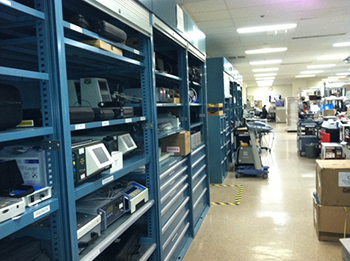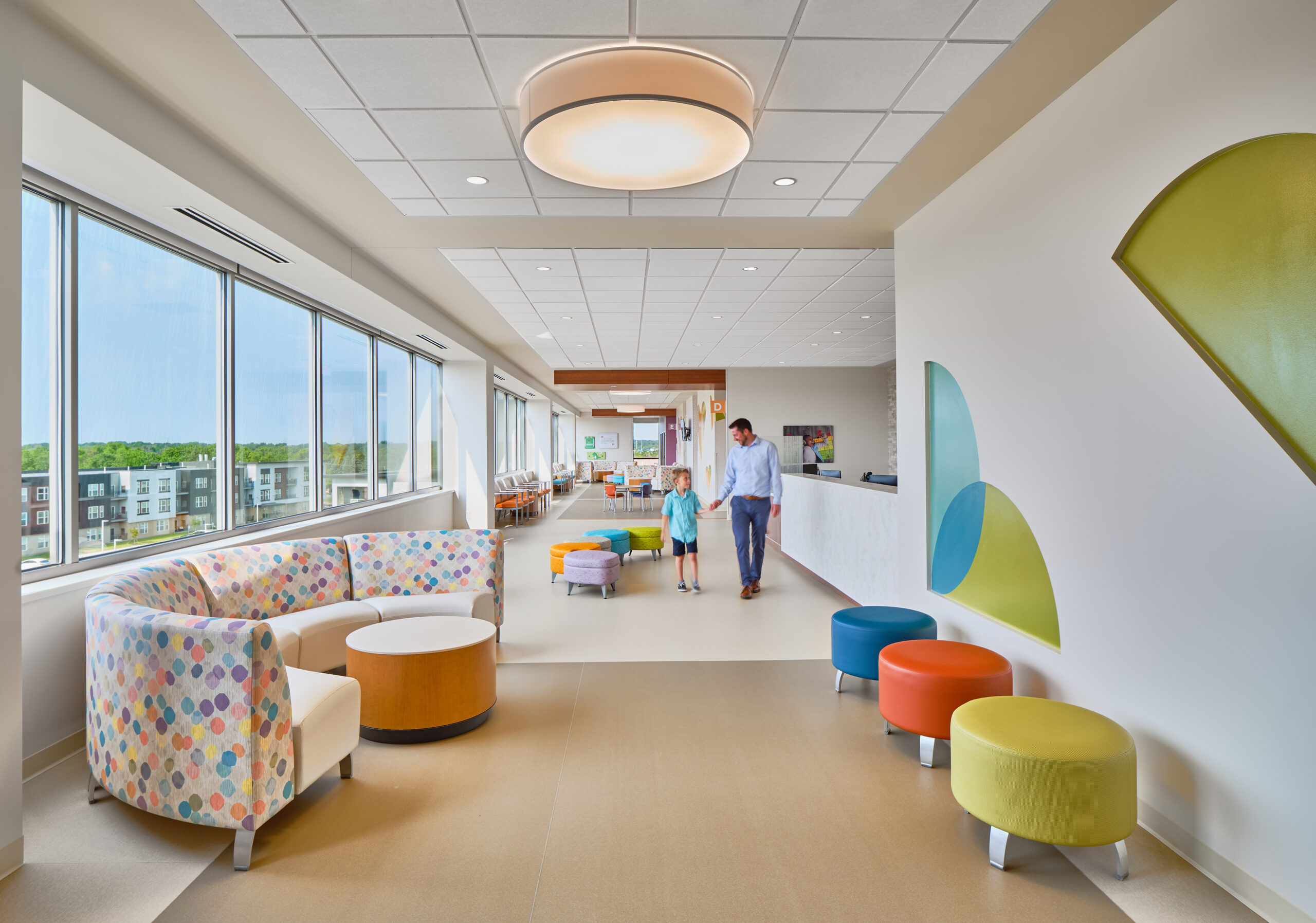 SAN DIEGO — The Naval Medical Center San Diego (NMCSD) facility launched a major renovation of its aging and inefficient Biomedical Repair Division (BRD), using high-density storage solutions from Lista. From a dark and dingy outdated basement space, the repair division has been transformed into a clean, attractive, and efficient showpiece. Now the division is passing inspections with flying colors, all while increasing its productivity and improving turnaround time to help NMCSD achieve its vision for world-class health care.
SAN DIEGO — The Naval Medical Center San Diego (NMCSD) facility launched a major renovation of its aging and inefficient Biomedical Repair Division (BRD), using high-density storage solutions from Lista. From a dark and dingy outdated basement space, the repair division has been transformed into a clean, attractive, and efficient showpiece. Now the division is passing inspections with flying colors, all while increasing its productivity and improving turnaround time to help NMCSD achieve its vision for world-class health care.
Organizational Solutions for Vital Repair Function
NMCSD has a simple but important mission: To provide the finest medical care in a family-centered environment to military service members, their families and those who served in the past. As a major military medicine training center, NMCSD trains about 70 percent of the U.S. Navy’s military doctors, nurses and corpsmen. The center includes a large teaching hospital, five medical mobilization teams including the hospital ship USNS Mercy and a network of clinics located at area military installations.
It all adds up to a lot of equipment – most of it maintained and repaired by the BRD at its shop located in the hospital’s basement. There, 20 civilian and military biomedical equipment technicians conduct preventive maintenance and perform repairs, calibration and software updates to a wide range of equipment, including beds, warming units, infusion pumps, anesthetic equipment and test equipment.
According to HM1(SW) Karen Magallanes, who serves as contracting officer representative for the BRD, NMCSD is a multi-tasking department that takes equipment apart and puts it back together, so the benches and surrounding area have to have sufficient space. At the same time, the division is subject to frequent and regular inspections and has to keep everything clean and well organized.
Magallanes explains that the BRD had many concerns about its existing set up and was looking to streamline operations and improve ergonomics, space use, tool storage, lighting, and security, as well as appearance. “The space was dysfunctional, and did not adequately hold the number of technicians we have,” Magallanes said.
The 25-year old butcher-block benches were big and bulky and the space was gloomy. Placing equipment in between the benches was difficult, making it hard to work on some of the larger items. “We had a cage in the back to lock up supplies, which added to the old and dungeon-like appearance,” Magallanes said.
Ergonomics was a definite concern since there is quite a variation in height among technicians. The benches were lower than the tables and many technicians’ knees tended to hit the workbench, making working on projects quite awkward. Overhead white lights did not provide adequate illumination for many tasks. In addition, the outdated benches did not allow for new technology. CPUs were on the floor and there was no space for a monitor on the bench, or anywhere to store manuals and instructions.
Arriving at a Solution
After years of working in subpar conditions, the BRD had developed a vision of a space that would be clean, well organized, functional and pleasant to work in, and set out to find a vendor to realize their vision. They began by soliciting bids and evaluating offerings and prices. “We were particular and wanted to get something organized to our requirements. Rather than focus on the lowest priced bid, we really paid attention to making sure the solution would meet our needs,” Magallanes said. She added, “We were very particular about color, clean lines, open design, and allowing for everything in its proper space.” The vision also included a technician-friendly system where each technician could have his or her own bench.
Following the bid evaluation, NMCSD selected Lista, which has years of experience in the health care market, and began working with John Mannone, Lista’s territory sales manager.
Mannone explains that Lista began by listening to NMCSD’s clear vision of a solution that would provide organization, space saving features, inventory control, and top-notch appearance. Then he and the team worked as part of a joint effort to help make their vision a reality. The painstaking selection process took about two years. “We showed them different types of benches and other storage solutions, and discussed the efficiency of each piece and part,” Mannone said. “After a thorough analysis, NMCSD decided what they liked and purchased it.”
Three different Lista product lines were represented, including a storage wall, workbenches and cabinetry.
At the heart of the system are four modular Arlink 8000 workstations, arranged in pods of four benches organized in an X configuration, which provides 16 seats. The configuration allowed them to add space for more technicians while giving each technician better lighting and more bench top space. Each workstation is equipped with its own lights, storage shelves and drawers, and a place for the computer.
“We decided that the X configuration is a very effective use of space on the floor and would be the best fit for most technicians,” Magallanes said. “Without walls you can see clear through from one end of the shop to the other, giving it a very clean and orderly appearance.” Mannone added that the modular Arlink workstation is reconfigurable, so it can be altered for multiple functions and workflow changes, giving NMCSD complete flexibility if and when the space changes.
Complementing the technicians stations were three Lista Align height-adjustable benches for specific computer-related tasks outside the area of the standard technicians bench duties. Technicians of various heights can adjust these benches for optimal ergonomic fit.
Another special feature is the Lista Storage Wall System specially designed for test equipment that has to be calibrated. The storage wall, which took the place of the locked cage, takes full advantage of the available height with a combination of industrial-strength shelves, drawers, rollout trays, and tough tambour doors to secure instruments being repaired or calibrated. The test equipment is stored on rollout shelves, making it very easy to access. The storage wall facilitates labeling, can hold the weight of all the equipment pieces and can be closed and locked with a very neat appearance. The tambour doors enable technicians to lock up the instruments and parts, and present a neat, controlled and organized shop for daily operations and during inspections.
Each one of the drawers can hold up to 440 pounds, making them ideal for storing dense and heavy 12 volt and 24 volt batteries – 20 to 40 are on hand at any one time. Storing the heavy batteries in a drawer is useful because it’s at a reasonable height and makes the shop a lot more worker-friendly. Also stored are 50-lb and 25-lb weights, used for calibration.
“We used to have all this in a dark, caged area and now it’s out in the open, clearly labeled, and easy to get out on a rolling tray. This makes storing things – and then finding them – much easier,” Magallanes said. “We have definitely increased our work flow.”
In the back of the shop Lista provided low profile drawer cabinets with a 10-foot long butcher-block top, which serves as an open area for bigger pieces and multiple assembly-line work. Magallanes reported that the bench is used all the time, every day.
According to Magallanes, Lista did a very nice job of overall space utilization, helping them plan for how to use the large space to its best advantage. One area where this made a big difference was for storing beds, warming units and other large items. The configuration they developed gave adequate workspace, storage space, and ease of access. “The bed is a fairly large piece of equipment that takes up a lot of space, and in the past we really had to maneuver to get it through the shop, which was frustrating. Now we can have quite a few beds in for repairs and still have plenty of space to work.”
Installation went very smoothly, with Lista completing the work in phases in a timely manner, never interfering with the repair shop’s work. The most complicated part of the installation was removing the old system, most of which was too worn and dirty to be recycled. The next step, deciding where everything would go within the new system took a while, as the BRD team took its time to determine the best way to organize the equipment and label it.
The results are definitely worth it, said Magallanes, who is thrilled with the clean and well-organized space. “The walls are light and the blue color cabinets liven up the space. Since the repair function is typically in a basement, in an area with no windows, the fact that the shop is so attractive and technologically updated is a huge morale booster,” Magallanes said.
Passing inspection with flying colors
Frequent readiness inspections are an important part of naval culture and the NMCSD undergoes two levels of inspection: accreditation and internal captain review. The BRD was included in an inspection by the Joint Commission, an independent, not-for-profit organization that accredits and certifies health care facilities in accordance with its national standards for health care quality and safety. Included in the inspection were such items as whether material is stored on the floor or too close to the ceiling and whether there is the right amount of space for evacuation. Inspectors were extremely impressed with the space’s cleanliness and organization, passing it with flying colors.
In addition, within six months of the system reorganization, the BRD’s unable to locate (UTL) rate fell from 35 percent to 3 percent. While much of the equipment that previously fell in the UTL category was actually in the hospital wards and not in fact lost, having the open, efficient space is definitely a factor in reducing UTL. It also plays a major role in keeping the BRD’s completion rate for critical, life-saving pieces of equipment at the required 95 percent level, something that was far more difficult with the old shop.
The new organization structure has allowed the BRD to significantly streamline the repair process and speed up turnaround, which in turn helps NMCSD fulfill its vision to provide world-class care anytime, anywhere.





